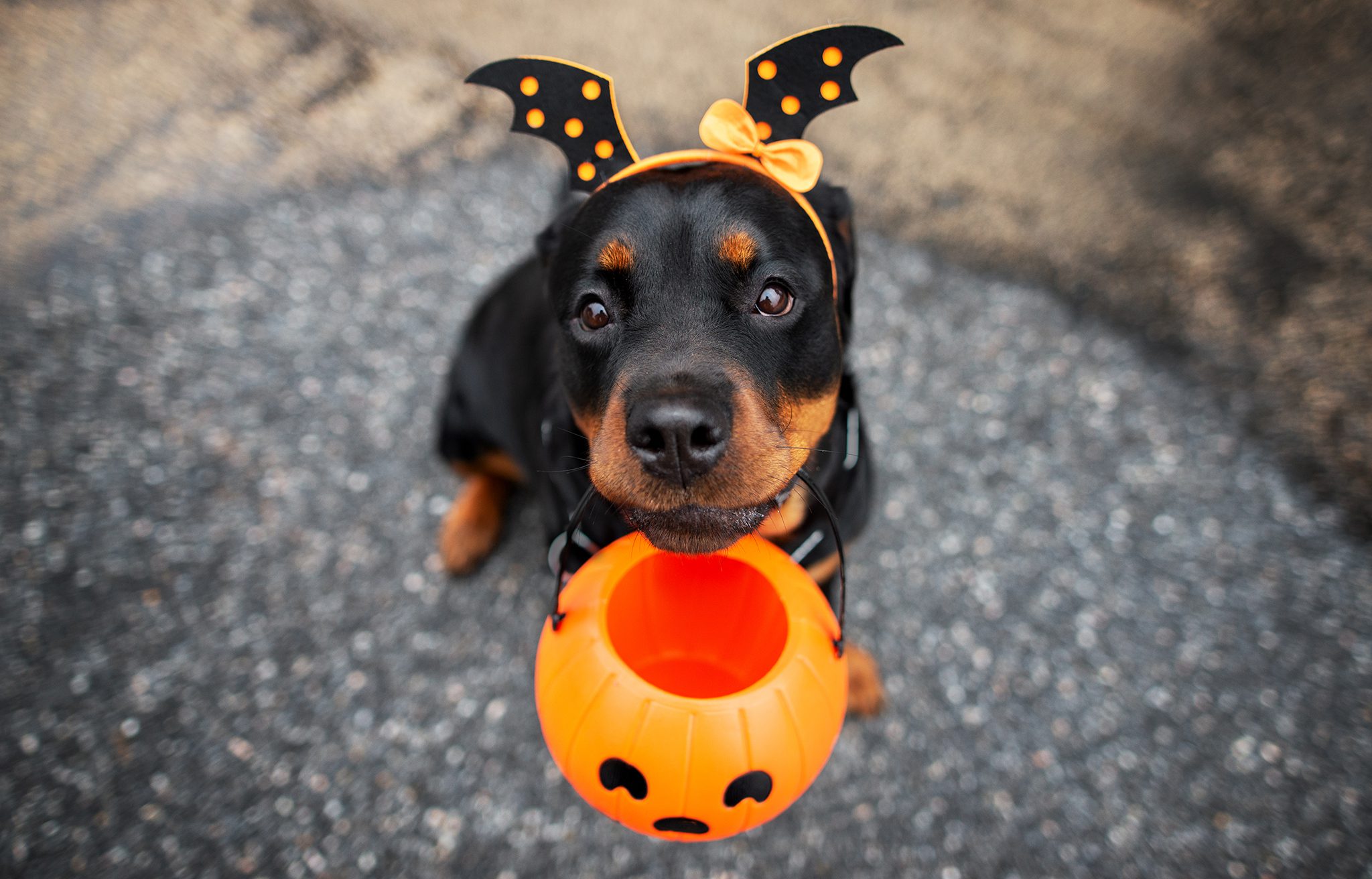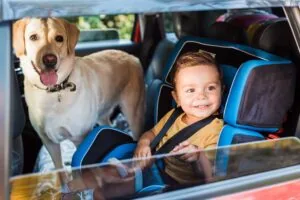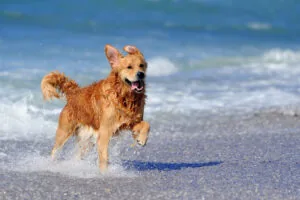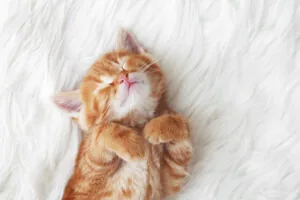Halloween Pet Safety Tips

Costumes and masks, lights and decorations, and a constant parade of strangers coming to your door— Halloween can be a downright spooky experience for pets. You can protect your pets by reading these tips to prevent the risk of them being hurt, poisoned, or lost.
Halloween Hype Causes Pet Stress
Before the trick-or-treating starts, put your pets in a quiet room where they will be safe from all the Halloween activity. If your pup is likely to try to run out the front door and is comfortable in a crate, consider putting them in the crate with a treat-filled toy and some soft music playing in the background. A spritz of Feliway can help keep cats calm. Minimize noise by sitting outside to keep trick-or-treaters from knocking on the door or ringing the bell. Even if you are just having friends over for a Halloween party, keep your pets away from the festivities in their safe room. Masks and costumes change how people look and smell to a pet, so even familiar people may become frightening. Put a sign on the door to the safe room so your guests know it’s off-limits.
When going out trick-or-treating, leave your dog at home. Dogs can be easily excited by the Halloween commotion, and a bite or a lost dog will quickly end the evening’s fun.
Protect Your Pets from Outdoor Dangers
Bring your pets indoors before night falls. Cats are always safest inside with you, but on Halloween it’s especially important to secure all pets inside so they don’t run away out of fear of adults and children in costumes. In case they escape, make sure that all your pets are wearing tags with current IDs and that their microchip is registered with your most up-to-date information. Opening the door repeatedly for trick-or-treaters creates plenty of opportunities for a pet to slip outside and disappear into the night. Proper ID will help you reunite with your lost pet and take a recent picture of your pet that can be used for lost flyers just in case they get lost.
Be Careful with Costumes
For some pets, wearing a costume may cause undue stress. The ASPCA recommends that you don’t put your dog or cat in a costume unless you know he or she loves it. If you do dress up your pet for Halloween, make sure the costume does not limit his or her movement, sight or ability to breathe, bark or meow. Check the costume carefully for small, dangling or easily chewed-off pieces that could present a choking hazard. Ill-fitting outfits can get twisted on external objects or your pet, leading to injury. Be sure to have your pet try on the costume before the big night. If he or she seems distressed or shows abnormal behavior, consider letting your pet wear a festive bandana instead.
Dangerous Decorations
Jack-o-Lanterns
Another thing to consider are the safety hazards to pets and your entire family when pumpkins and candles are lit. Pets may knock these items over resulting in your pet being burned or other items catching on fire. The good news about pumpkins is that a small amount can make for a tasty, healthy treat for your pet. As always, always check with your veterinarian first before offering your pet a new diet or treat.
Keep Glow Sticks Away from Pets
While glow sticks can help keep people safe on Halloween night, they can add some unwanted drama to the holiday if a pet chews one open. Although the liquid in these products isn’t likely toxic, it tastes really bad and makes pets salivate excessively and act strangely. Pets who get into a glow stick may drool, paw at their mouth, become agitated, and sometimes even vomit. Doctors recommend that if your pet does chew on a glow stick, offer some freshwater or a small meal to help clear the material out of the mouth.
Keep Electric and Battery-powered Halloween Decorations out of Reach
Electric and battery-powered Halloween decorations are certainly safer than open candles, but they still can present a risk to pets. Pets who chew on electrical cords can receive a possibly life-threatening electrical shock or burn. Batteries may cause chemical burns when chewed open or gastrointestinal blockage if swallowed. Shards of glass or plastic can cause lacerations anywhere on the body or, if swallowed, within the gastrointestinal tract.
Trick-or-Treat candies are not for pets
Xylitol
Xylitol, a natural sugar alternative, is even more toxic to dogs than chocolate, its use is becoming increasingly common, and too many people are still unaware of the very real and serious dangers that xylitol poses to dogs. Hard candies, sugar-free gum, and even some chocolates are just a few of the many types of products that can contain xylitol.
If you have children, make sure they don’t leave their candy lying around anywhere that’s accessible to your dog. And be sure to hang any bags or purses up where your dog truly can’t reach them. Even just a small piece of gum like you would find in Ice Breakers Ice Cubes gum contains enough xylitol to severely sicken or even kill a small dog, and it doesn’t take much more than that to pose the same danger to larger dogs.
Chocolate
Chocolate is typically the reason behind most calls to veterinarians during this time of year. And yes, chocolate can be problematic for pets. The darker the chocolate, the more toxic and problematic it is for dogs and cats. This is because the concentration of theobromine, a caffeine-like compound found in chocolate, is higher the darker the chocolate is. While many people are aware of the danger chocolate poses to dogs, the same danger for cats is far less publicized.
Snack and Candy Bags
The actual treats in your kid’s Halloween bounty aren’t the only potential food-related problem for your pets — the wrappers and bags those treats come in can also cause problems. Ingested candy wrappers can lead to digestive system inflammation and/or obstruction, resulting in episodes of vomiting and/or diarrhea, as well as an unplanned trip to the veterinarian, and possibly the surgery table. Signs could include vomiting, decreased energy and/or appetite, or straining to defecate. Candy bags and salty snacks (e.g., chips, pretzels, etc.) bags can also turn deadly in a matter of minutes.
If you suspect your dog has eaten something harmful you may call the ASPCA Animal Poison Control Center (888-426-4435) or Pet Poison Helpline (855-764-7661) 24 hours a day, year-round. Also, identify in advance the emergency veterinary clinic nearest your home and post that information on your refrigerator beside the poison hotline number.
Share This Post
Recent Posts
About Shallowford Animal Hospital
Shallowford Animal Hospital and The Pet Spa at Shallowford are dedicated to the exceptional, compassionate care your pet deserves. Pets hold a very special place in our families, and we treat yours like our own.



